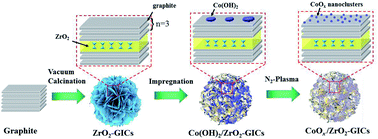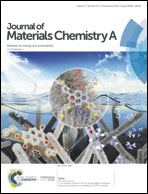Plasma-activated CoOx nanoclusters supported on graphite intercalation compounds for improved CO2 electroreduction to formate†
Abstract
The CO2 electroreduction reaction (CO2RR) to chemicals and fuels is of both fundamental and practical significance, since it can lead to the more efficient storage of renewable energy and promote the carbon cycle. Here, the CO2RR to formate over N2-plasma-activated CoOx/ZrO2–graphite intercalation compounds was achieved with enhanced activity and selectivity, with a faradaic efficiency of 98.4% toward formate production and a current density of 8.2 mA cm−2 at −0.35 V vs. RHE. A combination of experimental data and DFT calculations revealed that an increased Co2+ content on the surface of the CoOx nanoclusters could reduce the energy barrier to the formation of *CO2δ−, which is the rate-determining step regarding the overpotential of the CO2RR to formate. The π–π* bonds between the graphite layers, possessing the peculiar electronic structure of ZrO2–graphite intercalation compounds, endowed the material with good electron transfer and fast carrier transport properties, and could help the formation of *OCHO to increase the selectivity for formate. This strategy provides a simple and efficient route to develop nanoclusters supported by graphite intercalation compounds for the CO2RR to formate, with high selectivity and efficiency.



 Please wait while we load your content...
Please wait while we load your content...